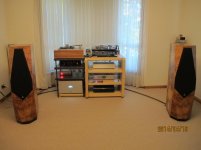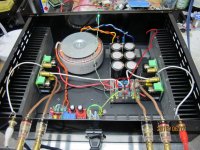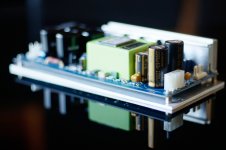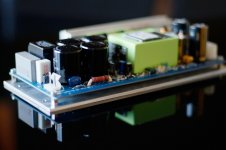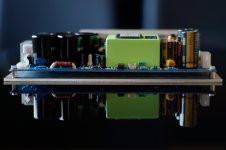You serious guys, LC have subs under floor filling several square meters, back has monster driver line placed in wall, guess seen somewhere Esperado run 18", i go home now
.
i used to.
not anymore

Oh, please, try one of these days my network impedance compensation scheme.Trios passive, Sub horns active. 😉
You will never need to move them away ;-)
Recommended it's a night and day mod soundwise. Inspired by Esparado over VSSA thread i did test it, now can't live without.Oh, please, try one of these days my network impedance compensation scheme......
On the other hand Esperado it's expensive speakers LC have there, maybe such network is already there.
Oh, please, try one of these days my network impedance compensation scheme.
You will never need to move them away ;-)
Hi Esperado, where is that network impedance compensation scheme located?
Thanks
Do
Hi, Pinnocchio, I'm afraid it is out of topic here.Hi Esperado, where is that network impedance compensation scheme located?
Just a serial RLC network to compensate the resonnance of the speakers at its resonnance frequency in free air, and a zobel for the upper part of the spectrum. both connected parallel to the speaker coils.
Target is to have a *flat impedance* curve with value equal to the DC resistance of the coil.
An example here: http://www.esperado.fr/images/temp/aeria_full_filterj.gif where Zobel is red, and 'motional compensation' (or resonance) is green. Here, the zobel and the filter's capacitance of the boomer were mixed in a simple 47µF value. And the medium/high frequencies driver has a more sophisticated zobel to be flat up to >40Khz.
Of course, passive filters have to be calculated or modified with this flat charge, but is is much simpler. Keep them with the speakers, even with active filters.
You'll never believe the improvement, and, as said BYRTT will never live any more without. !
Last edited:
Those two links:
La correction d impédance RC série
La correction d impédance RLC série
will help you to calculate the values (It is in French).
With a closed enclosure, make the measurements with speaker in the box.
With bass reflex, and contrary at what Dominique Petoin printed, build you RLC with the speaker in free air, and just modify R value once in the vented box ;-)
Just my two cents.
La correction d impédance RC série
La correction d impédance RLC série
will help you to calculate the values (It is in French).
With a closed enclosure, make the measurements with speaker in the box.
With bass reflex, and contrary at what Dominique Petoin printed, build you RLC with the speaker in free air, and just modify R value once in the vented box ;-)
Just my two cents.
Last edited:
Yep, but a lot of value for money here !Those two links:
Just my two cents.
Hi guys. Today i attempted to connect my FO with my beloved Avalon speakers. I can hear constant ticking noises through my speakers even it is muted through my preamp. Is it likely interference from nearby cell phone?. My usual YBA amp has no such problem through exactly the same set up.
Quan
Quan
Check the output with scope.Hi guys. Today i attempted to connect my FO with my beloved Avalon speakers. I can hear constant ticking noises through my speakers even it is muted through my preamp. Is it likely interference from nearby cell phone?. My usual YBA amp has no such problem through exactly the same set up.
Quan
Check with input disconnected.
Check with different cables/speakers.
Check with earth lifted from mains to preamp.
One of these test will guide you to the cause of tick.
Last edited:
Check the output with scope.
Check with input disconnected.
Check with different cables/speakers.
One of these test will guide you to the cause of tick.
Thanks LC. I don't have a scope so that is out of the question. I can check with inputs disconnected. Those Avalon speakers have speakers connectors on the bottom of the speakers so it is a pain to swap them out.
Attachments
Hi quan,
Have you tried different speakers before? From your picture I see a wire from the earthing screw directly to the circuit. Does it go to the GND directly or via a GND lift circuit?
It can be a GND loop if it's a direct connection, and although this usually results in hum, it can be also some sort of oscillation...
Also, have you tried with different source? So bad you don't have a scope... Even a cheap portable DSO can be handy in this situation.
Cheers!
Have you tried different speakers before? From your picture I see a wire from the earthing screw directly to the circuit. Does it go to the GND directly or via a GND lift circuit?
It can be a GND loop if it's a direct connection, and although this usually results in hum, it can be also some sort of oscillation...
Also, have you tried with different source? So bad you don't have a scope... Even a cheap portable DSO can be handy in this situation.
Cheers!
Hi Metallicus,Hi quan,
Have you tried different speakers before? From your picture I see a wire from the earthing screw directly to the circuit. Does it go to the GND directly or via a GND lift circuit?
It can be a GND loop if it's a direct connection, and although this usually results in hum, it can be also some sort of oscillation...
Also, have you tried with different source? So bad you don't have a scope... Even a cheap portable DSO can be handy in this situation.
Cheers!
I did ran FO in using my system but with 2 different pair of speakers without any problem ie no ticking noise although i used only cheap speaker cables. The cables connect to the Avalon are Synergistic research reference series. These have active shielding but it is not connected. The ground from psu is direct to earth screw without any ground-lift.
Quan
A shield around the pair ? Try to connect-it to the cold wire of your amp's outputs. Or the chassis, if you are in bridged mode.These have active shielding but it is not connected
Hi quan this just theory, mayby worth a try.
HF reosonance in PSU when combined with exotic speaker cables and loads release fault pattern.
See bypassing caps in picture and this link http://www.diyaudio.com/forums/powe...ing-psu-capacitors-effective.html#post1566979. Some theory PSU bypassing storage caps, either don't use or use higher value's in uF and up.
Suggest you try unsolder bypassing caps so only the 3xstorage caps per rail exist, and at same think LC done prober bypassing and storage caps at FO pcb.
PS beautiful system
HF reosonance in PSU when combined with exotic speaker cables and loads release fault pattern.
See bypassing caps in picture and this link http://www.diyaudio.com/forums/powe...ing-psu-capacitors-effective.html#post1566979. Some theory PSU bypassing storage caps, either don't use or use higher value's in uF and up.
Suggest you try unsolder bypassing caps so only the 3xstorage caps per rail exist, and at same think LC done prober bypassing and storage caps at FO pcb.
PS beautiful system
Attachments
Last edited:
Cables with active shielding are then the reason of tickling sound, maybe they needs the battery to be connected. 🙄Hi Metallicus,
I did ran FO in using my system but with 2 different pair of speakers without any problem ie no ticking noise although i used only cheap speaker cables. The cables connect to the Avalon are Synergistic research reference series. These have active shielding but it is not connected. The ground from psu is direct to earth screw without any ground-lift.
Quan
Power supplies from AudioPower have been delivered this afternoon.
Now it's time to connect them to FO modules.
Very nice Catal, but be careful to offer them enough air flow, cause these SMPS can be quite warm in just idle condition. 🙂
Very nice Catal, but be careful to offer them enough air flow, cause these SMPS can be quite warm in just idle condition. 🙂
That was the DPS-500/DA-45v version pushed to 60v.
This is the DPS-500/S-63V version with a better transformer. This one should be able to handle the First One modules 🙂
Last edited:
A shield around the pair ? Try to connect-it to the cold wire of your amp's outputs. Or the chassis, if you are in bridged mode.
I am a bit reluctant to do that. I used to have Conrad Johnson amp 350 and the active shielding took out the whole output transistors so since then shielding is not used any more with any amps.
Thanks Byrtt. I will take out the bypass caps to see if it is making any difference. I may even try Cap multiplier supply instead to see if the problem goes away.
Quan
- Home
- Vendor's Bazaar
- First One - mosFET amplifier module
